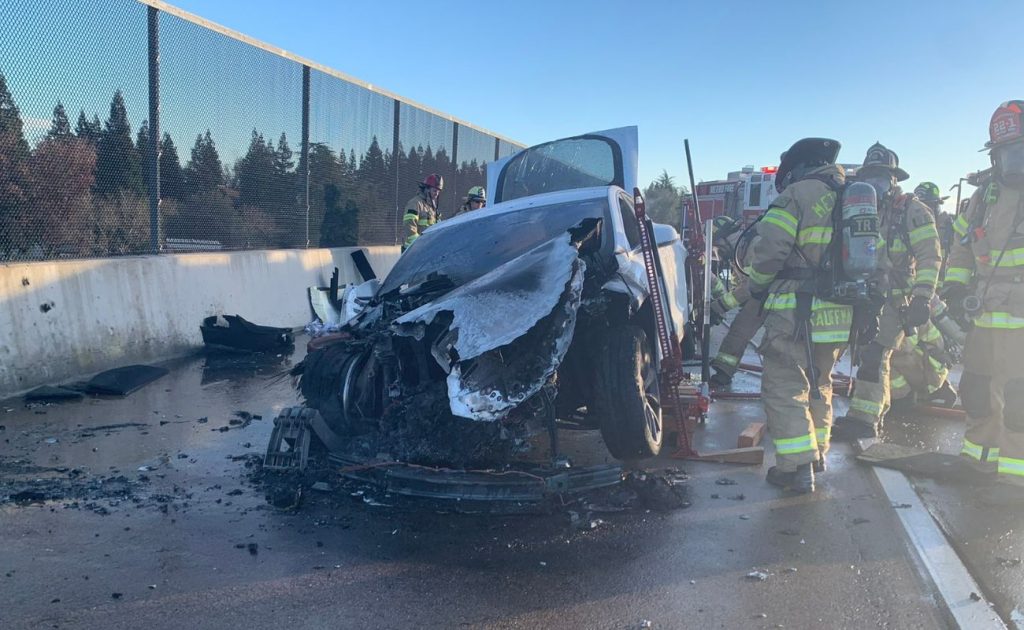In an unanticipated event, a Tesla car battery burst into flames on a California highway.
Just like that. Spontaneously.
It took 6,000 gallons of water to finally put out the blaze, which sent firefighters scrambling for help.
On Saturday, the Sacramento Metropolitan Fire District reported that a car battery had burst into flames alongside Highway 50. Fortunately, no one was hurt in this incident.
However, the situation was still quite intense. It took a total of six thousand gallons of water to finally put out the flames. That’s enough water to fill over forty-four standard-sized bathtubs.
The firefighters on the scene were heard shouting for assistance, and many cars were quickly re-directed off the highway as a precaution.
The cause of this incident is still being investigated, but it serves as a reminder that electric cars while being greener than their gasoline-powered counterparts, can still be dangerous when it comes to fire.
This is not the first time a Tesla EV has caught fire spontaneously and took so much water to get rid of the fire. To extinguish a large battery fire, an excessive amount of water is usually required.
6,000 US gallons or 22,000 liters in the case of this Tesla incident. However, this isn’t even close to being one of the highest amounts seen!
Let’s find out what all happened and how EV fires are so hard to put out.
Table of Contents
What Happened?
On Saturday, the Sacramento Metropolitan Fire District documented an incident near Rancho Cordova in California through a series of tweets on their official Twitter account.
The department tweeted that “no irregular activity” occurred prior to the Tesla Model S being engulfed in flames, but they did note that while fire crews were putting out the fire, the car’s battery cells kept on combusting.
Sacramento fire officials reported that it took 6,000 gallons of water to extinguish a blaze spawned by Tesla car batteries which “spontaneously” ignited. Spontaneously because there was no collision or no prior accident that might have resulted in a fire break-out.
As you can see in the tweeted videos, the firefighters who had been trained followed Tesla’s instructions and were eventually successful.
With more and more electric cars being used every day, firefighters must have special training so they are ready when they have to deal with a fire involving a car battery.
6000 Gallon for One EV Fire
In Tesla and other electric cars, the battery typically takes up a substantial portion of the car’s base. An entry-level Model S battery is 98kWh in capacity–that’s equivalent to as many as 1920 individual laptop batteries.
The firefighters had to use 6,000 gallons of water to put out the fire. Tesla vehicles or any other electric vehicle have batteries that can cause problems if they are damaged. This fire shows what can happen if a Tesla battery is damaged.
The fire is often hard to put off.
Tesla cautions that up to 8,000 gallons of water may be necessary to efficiently douse a burning electric vehicle in its manual.
The firefighters had to follow Tesla’s instructions to put out the fire. They had to lift up the Tesla using jets and spray water from their hoses under the car at the battery. They used a lot of water before they finally managed to put out all the flames.
Crews arrived to a Tesla Model S engulfed in flames, nothing unusual prior. 2 Fire Engines, a water tender, and a ladder truck were requested to assist. Crews used jacks to access the underside to extinguish and cool the battery. Thousands of gallons were used in extinguishment. pic.twitter.com/5dIXxo9hP5
— Metro Fire of Sacramento (@metrofirepio) January 29, 2023
Why So Many Teslas Are on Fire?
Even though gas car fires happen every day, we don’t always hear about them in the news. But we can’t compare how often EVs and gas cars catch on fire yet because there are way more gasoline-powered cars than EVs. However, we know that EVs are less likely to catch on fire than gasoline-powered cars. This is because they don’t use combustible materials.
Like we said earlier in one of our articles how biased media is when it comes to Elon Musk of news related to electric cars. There are a lot of people who still don’t believe in the power and efficiency of electric vehicles because they still think these cars are dangerous and have a chance of catching on fire.
Ironically though, electric vehicles are actually incredibly safe and much less likely to catch on fire than gasoline-powered cars. You can check the data!
What Happens When an EV Catches Fire?
Electric vehicles are becoming increasingly popular as an eco-friendly and cost-saving alternative to gas-powered cars. But, like any vehicle, they can be prone to fires. So what happens when an EV catches fire?
When an electric vehicle catches fire, it is often due to a malfunction in the battery system or electrical components. This causes the car to overheat, which results in the combustion of flammable material inside the car.
The resulting flames and smoke from EV fire can quickly spread and engulf the whole vehicle.
While it could be argued that gasoline is more combustible and explosive than lithium-ion batteries in electric vehicles, including those in our laptops, smartphones, and tablets; these batteries possess distinct characteristics that necessitate specialized firefighting training to adequately handle them.
Why It Is Hard to Douse EV Fire?
Electric vehicle fires are still rare, but they get a lot of attention because they can become huge fires very quickly. These fires burn with an intense heat that often results in the entire car became engulfed by flames.
While extinguishing the fire is no easy feat, there are occasional reports of EVs suddenly reigniting days after an accident when parked at junkyards or investigation sites.
After weeks of sitting in the junkyard, a Tesla Model S suddenly burst into flames and had to be doused with water for it to finally be put out. Even though Tesla explicitly states that submerging their cars in large tanks of water is not recommended.
Firefighters made multiple attempts to put out the flames but were ultimately required to dig and fill a small pit with water before submerging the car in it. The operation used up 4500 gallons of water!
Such instances have made it difficult for investigators to keep their investigations going and protect bystanders from any additional dangers. Also, the way firefighters handle the fire becomes conflicting.
What to Expect in the Future?
Firefighters around the world are facing a new threat from electric vehicle battery fires. These fires are hard to put out, and they can cause damage.
If you remember last year there were several Electric Porsches that caught on fire on a ship called Felicity Ace. The firefighters could not put the fire out, and eventually, the whole ship sank with the cars still burning.
Firefighting equipment manufacturers are developing groundbreaking solutions to combat the problem of unavoidable fire hazards associated with electric vehicles, which will become more and more prevalent in our society.
A famous fire truck company has designed new high-pressure nozzles. These nozzles fit under the battery pack and shoot water directly into it. This has stopped potential fires and saved resources by using less liquid. This invention has been more successful than past methods.
Unfortunately, until fire departments have access to more specialized EV firefighting tools, putting out electric vehicle batteries will demand an alarming 20 times the amount of water needed for a typical gas-powered car.
EV fires may happen at any time, and when they do occur, electric vehicles with lithium-ion batteries typically burn hotter and faster. Also, it can take more water to completely extinguish the fire than usual.
Battery fires have a tendency of reigniting hours or even days after being put out which poses an enormous risk for salvage yards and repair shops.
EVs are relatively young compared to ICE vehicles, so there is still a need to understand the ways to prevent and fight fire incidents in EVs. However, this has to be a lot sooner.
The Department of Energy is currently working on integrating flame retardants directly into the design of batteries to make them safer. Additionally, engineers are studying new battery chemistries with less-flammable electrolytes and solid-state batteries that substitute liquid electrolytes for a much more secure solid state.
Bottomline
Vehicle fires are a common phenomenon, but lately, EVs are too much in limelight. Electric car fires are not common, but when they happen, they become big news because they can turn into large fires very quickly. These huge fires can burn up the whole car in just a few moments.
There is a constant need to build a safer Tesla vehicle that does not pose such a significant threat to fires. A few fires have occurred without any signs of battery damage such as the one in the junkyard. Even those who are well-equipped to manage an electric vehicle revolution can’t seem to grasp how these incidents occur.
Tesla has recently declared that it is transitioning from lithium-ion batteries to more efficient and economical lithium iron phosphate (LFP) cells. Other major automakers such as Ford, VW, etc., have followed suit by switching from nickel or cobalt formulations in some of their electric vehicles over to LFPs.
Even though research in this area is still at its beginnings, promising results have already been seen! As time passes, there’s no limit to what advancements we can see in our battery technology.
Things will only get better from here!



















